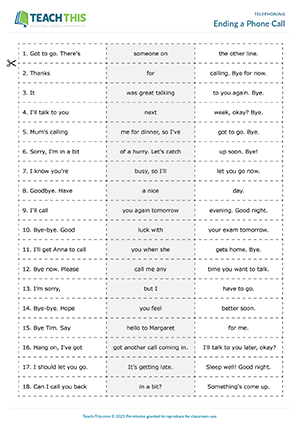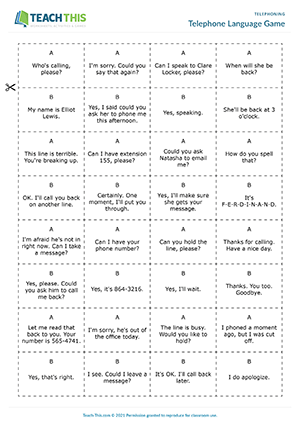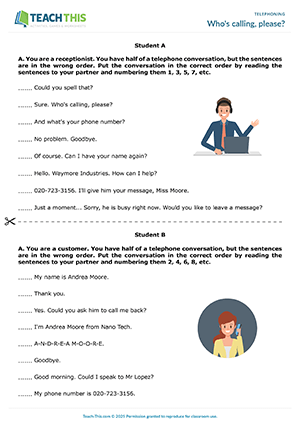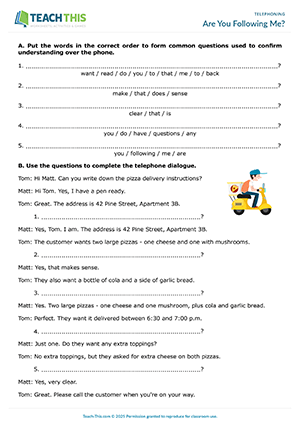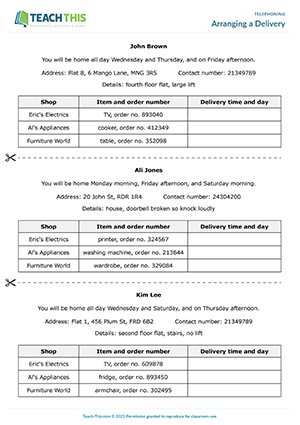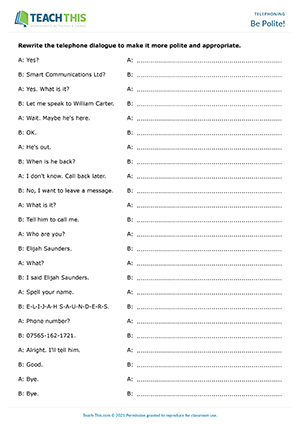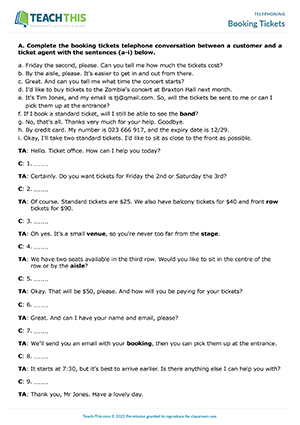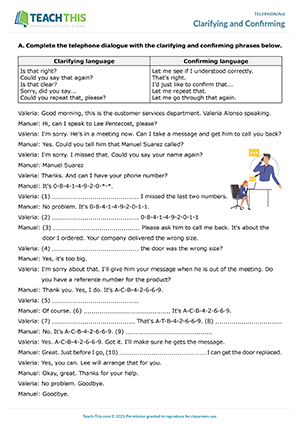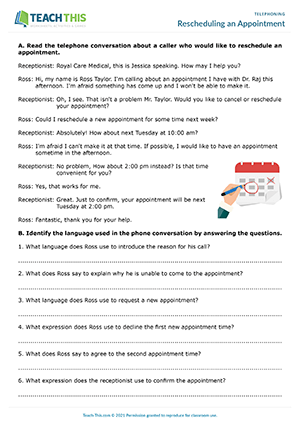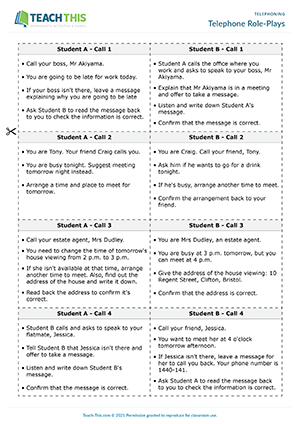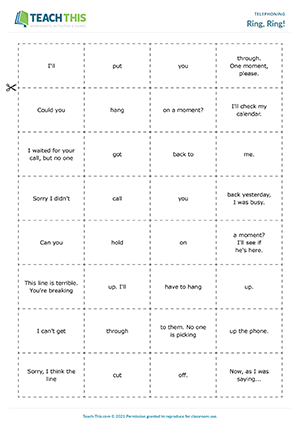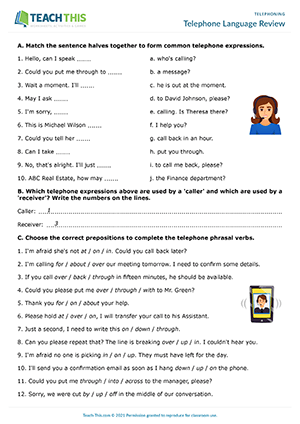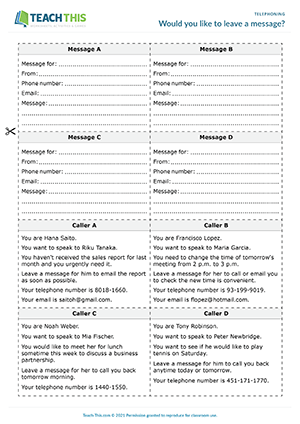Here is a useful ending a phone call activity and game to help students practice language used to end informal phone calls. First, in pairs, students do a matching activity where they arrange sentence beginning cards in order and then match them with mid-sentence cards and ending cards to form sentences ending a phone call. Next, students play a game in which they take turns picking up a card and reading out the situation on it. Their partner then has 30 seconds to come up with a suitable sentence ending the call that matches the situation using the sentences in the matching activity as a guide. If a student manages to come up with a suitable ending within 30 seconds, they win and keep the card. The student with the most cards at the end of the game wins.
In this free telephone language game, students match common telephone expressions with appropriate responses. The aim of the game is for students to say common telephone expressions and race to find the person in their group who has the appropriate reply to each one. One student begins the game by reading a card to one of the other students, e.g. 'Who's calling, please?' That student then looks for a matching reply on their cards. If the student has a matching response, they read it aloud to the group, e.g. 'My name is Elliot Lewis'. If all the students in the group agree that the cards go together, the student gives the card to the first student who wins the matching pair. If the student doesn't have a matching response, the first student has to wait until their next turn before saying the telephone expression to another student. The second student then reads a card to one of the other students and so on. The first student to collect four matching pairs of cards wins the game.
In this engaging telephoning speaking activity, students work with a partner to put sentences of a telephone conversation in the correct order. This activity can be used to practice telephone language and polite requests. In pairs, one student starts by looking at their sentences and reading the most suitable one to begin the telephone conversation. The student then puts number 1 next to the sentence. Their partner listens and looks for a suitable reply and then reads that reply to the other student, putting number 2 next to the sentence. This process continues until the conversation has been put in order from 1 to 16. Afterwards, go through the phone conversation with the class and review the telephone language and polite requests. Finally, pairs create their own telephone dialogue using the language and present it to the class.
In this productive telephoning activity, students practice confirming that instructions have been understood over the phone. Students begin by unscrambling questions used to confirm that information has been understood. Students then use the questions to complete a telephone dialogue. Next, in pairs, students role-play two telephone dialogues where they take it in turns to give details of an event to their partner, pausing to confirm that the information has been understood several times during the conversation. Once their partner has given them a suitable reply each time, they resume the conversation. This continues until both role-plays have been completed.
Here is a communicative arranging deliveries role-play activity to help students practice arranging a delivery time over the phone. First, students complete an arranging a delivery dialogue between a shop assistant and a customer with words from a box. In groups of six, students then conduct a role-play where three students are customers, and the other three are shop assistants in charge of deliveries. Each customer has recently bought one item from each shop, so the shop assistants call each customer to arrange a time to have the item on their role card delivered. The shop assistant calls the customer to arrange a delivery time for the item they brought. The shop assistant asks for confirmation of their name and order number, as well as their address, mobile number, and any details the driver needs to know about. When a pair has agreed on a delivery day and time, they write it down on their role cards. This continues until each shop assistant has arranged a delivery time with each customer. Afterwards, students swap roles, giving everyone a chance to be a shop assistant and a customer.
In this free telephone language worksheet, students review phone language and polite requests by rewriting a telephone dialogue. Working alone, students rewrite the telephone dialogue on the worksheet to make it more polite and appropriate. When the students have finished, they compare what they have written with a partner, editing any telephone language as necessary. Lastly, pairs share their ideas by acting out one of their phone dialogues in front of the class.
Here is a comprehensive telephoning worksheet to help students practice language for booking a ticket to an event over the phone. First, students complete a booking tickets telephone conversation between a customer and a ticket agent with the sentences provided. Next, students match the keywords in bold from the conversation to their definitions. After that, students complete gap-fill sentences using the vocabulary. Students then unscramble words to reveal sentences that can be used when booking a ticket. Next, in pairs, students choose one of the situations shown and write a booking tickets telephone dialogue of their own using the conversation in Exercise A as a model. Lastly, pairs role-play their conversations, taking turns to be the customer and the ticket agent.
In this handy clarifying and confirming worksheet and role-play, students learn and practice ten phrases for clarifying and confirming information over the phone. Students begin by completing a telephone dialogue with ten clarifying and confirming phrases. Next, in pairs, students conduct two telephone role-plays to practice the clarifying and confirming language from the worksheet. In the first role-play, Student A takes on the role of the caller and finds out, clarifies and confirms information about a party with their partner. In the second role-play, Student B calls their partner to find out, clarify and confirm information about a weekend beach trip.
In this insightful rescheduling appointments worksheet and role-play, students learn and practice expressions for calling and rescheduling an appointment over the phone. Students start by reading a telephone conversation about a caller who would like to reschedule an appointment. Students then identify the language used in the phone conversation by answering questions. Next, students match telephone expressions that have the same meaning and complete a telephone conversation using the phone expressions. After that, in pairs, students choose one of the situations on the worksheet and use the language they have learnt to write a telephone dialogue between a receptionist and a caller where an appointment is rescheduled. Finally, pairs practice their telephone dialogue and present it in front of the class.
In this communicative telephone role-play activity, students practice taking and leaving messages, making and changing arrangements, and confirming information over the phone by role-playing four telephone calls. Students begin by reading the prompts on the 'Call 1' cards. Students then role-play making and receiving a phone call according to the prompts on their cards. When the students have finished the first role-play, they move on to the second phone call. This continues until all four calls have been completed. Afterwards, students role-play their phone conversations in front of the class.
This fun telephone phrasal verbs game helps students to learn telephone phrasal verbs and common telephone expressions. First, in pairs, students use cards to make seven sentences connected with telephone language. Each sentence consists of four cards and contains one or two telephone phrasal verbs. When the students find one of the sentences, they write it down on a piece of paper and discard the four cards. The first pair to complete all seven sentences correctly wins the game. As an extension, pairs write and then act out a telephone dialogue using the phrasal verbs.
This detailed telephoning worksheet helps students review common telephone expressions and phrasal verbs used over the phone. Students start by matching sentence halves together to form common telephone expressions. Next, students sort the sentences into telephone expressions used by a 'caller' and telephone expressions used by a 'receiver'. Students then choose the correct prepositions to complete telephone phrasal verbs in sentences. After that, students complete telephone dialogues with words from a box. In the last exercise, students role-play telephone dialogues with a partner, taking it in turns to be the caller and the receiver.
In this communicative telephone messages role-play, students practice taking and leaving messages over the phone. In pairs, the student with the message card takes on the role of a receptionist and has to complete the card with information from the caller. The student with the caller card uses their role card to make a call. The role card contains their name, contact information, the name of the person they want to contact, the reason for their call and a short message to leave with the receptionist. Students then begin the role-play. When the phone conversation and message card have been completed, students swap roles and continue with the next pair of cards. This continues until all four pairs of cards have been used. Afterwards, students check the accuracy of their messages by comparing them with the caller cards.
Latest Free
Resources
- Everyday Objects Bingo
Everyday Objects
Elementary (A1-A2)
- Action Verb Races
Actions
Elementary (A1-A2)
- Birthday Basics
Birthdays
Elementary (A1-A2)
- Sales Phrasal Verbs
Business Phrasal Verbs
Upper-intermediate (B2)
Latest Member
Resources
- Collocations at Work
Business Collocations
Intermediate (B1)
- Etiquette Trivia Board Game
Etiquette and Manners
Upper-intermediate (B2)
- Everyday Objects Vocabulary
Everyday Objects
Pre-intermediate (A2)
- Let's have a talk
Verb-Noun Collocations
Pre-intermediate (A2)



